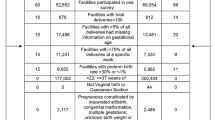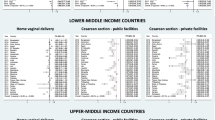Abstract
Background/objectives
Breastfeeding is of great benefit to infants and their mothers. Caesarean delivery (CD) have increased worldwide in recent years and emerging evidence has implied that CD may influence the initiation and duration of breastfeeding. However, the findings are inconsistent and intricate. The aim of this study is to illuminate the association between the CD and the initiation and duration of breastfeeding in the first 6 months postpartum.
Subjects/methods
A total of 2058 mother–infant pairs were studied in this prospective study. Delivery information was obtained from birth records. Feeding information in the first 6 months postpartum were collected from face-to-face interviews. Logistic regression was used to explore the association between CD and the initiation and duration of breastfeeding.
Results
After adjustment for potential confounders, CD was significantly associated with the unsuccessful initiation of breastfeeding [odds ratio (OR): 1.943, 95% confidence interval (CI): 1.050–3.597] and delayed initiation of breastfeeding [OR: 1.450, (95% CI: 1.041–2.019)], when compared with vaginal delivery (VD). More importantly, for mothers who had initiated breastfeeding, CD was associated with significantly higher risks of an inability to sustain full breastfeeding (OR: 1.369, 95% CI: 1.128–1.662), any breastfeeding at 3 months postpartum (OR: 1.715, 95% CI: 1.265–2.325) and any breastfeeding at 6-month postpartum (OR: 1.462, 95% CI: 1.174–1.820).
Conclusions
CD is an independent risk factor for the inability to initiate and sustain breastfeeding. It is desirable to reduce the CD rate and provide specific breastfeeding support during early postpartum period to CD mothers.
This is a preview of subscription content, access via your institution
Access options
Subscribe to this journal
Receive 12 print issues and online access
$259.00 per year
only $21.58 per issue
Buy this article
- Purchase on Springer Link
- Instant access to full article PDF
Prices may be subject to local taxes which are calculated during checkout


Similar content being viewed by others
References
WHO. Effect of breastfeeding on infant and child mortality due to infectious diseases in less developed countries: a pooled analysis. WHO Collaborative Study Team on the Role of Breastfeeding on the Prevention of Infant Mortality. Lancet. 2000;355:451–5.
Horta BL, Victora CG. Short-term effects of breastfeeding: a systematic review on the benefits of breastfeeding on diarrhoea and pneumonia mortality. Geneva: World Health Organization; 2013.
Horta BL, Victora CG. Long-term effects of breastfeeding-a systematic review. Geneva: World Health Organization; 2013.
Ip S, Chung M, Raman G, Trikalinos TA, Lau J. A summary of the Agency for Healthcare Research and Quality’s evidence report on breastfeeding in developed countries. Breastfeed Med. 2009;4(Suppl 1):S17–30. https://doi.org/10.1089/bfm.2009.0050.
Salone LR, Vann WF Jr, Dee DL. Breastfeeding: an overview of oral and general health benefits. J Am Dent Assoc. 2013;144:143–51.
WHO, UNICEF. Global strategy for infant and young child feeding. Geneva: World Health Organization; 2003.
McAndrew F, Thompson J, Fellows L, Large A, Speed M, Renfrew MJ. Infant feeding survey 2010. Leeds: Health and Social Care Information Centre; 2012.
Centers for Disease Control and Prevention. Breastfeeding among US children born 2002-13. CDC National Immunization Survey. 2016. https://www.cdc.gov/breastfeeding/data/nis_data/. Accessed 1 May 2017.
Yang Z, Lai J, Yu D, Duan Y, Pang X, Jiang S, et al. Breastfeeding rates in China: a cross-sectional survey and estimate of benefits of improvement. Lancet. 2016;388(Suppl 1):S47 https://doi.org/10.1016/S0140-6736(16)31974-2.
Lumbiganon P, Laopaiboon M, Gulmezoglu AM, Souza JP, Taneepanichskul S, Ruyan P, et al. Method of delivery and pregnancy outcomes in Asia: the WHO global survey on maternal and perinatal health 2007-08. Lancet. 2010;375:490–9. https://doi.org/10.1016/S0140-6736(09)61870-5.
Betran A, Torloni M, Zhang J, Gülmezoglu A. WHO Statement on caesarean section rates. BJOG. 2016;123:667–70.
Feng XL, Xu L, Guo Y, Ronsmans C. Factors influencing rising caesarean section rates in China between 1988 and 2008. Bull World Health Organ. 2012;90:30–39. https://doi.org/10.2471/BLT.11.090399.
Baker JL, Michaelsen KF, Sørensen TI, Rasmussen KM. High pre-pregnant body mass index is associated with early termination of full and any breastfeeding in Danish women. Am J Clin Nutr. 2007;86:404–11.
Albokhary AA, James JP. Does cesarean section have an impact on the successful initiation of breastfeeding in Saudi Arabia? Saudi Med J. 2014;35:1400–3.
Zanardo V, Svegliado G, Cavallin F, Giustardi A, Cosmi E, Litta P, et al. Elective cesarean delivery: does it have a negative effect on breastfeeding? Birth. 2010;37:275–9. https://doi.org/10.1111/j.1523-536X.2010.00421.x.
Rowe-Murray HJ, Fisher JR. Baby friendly hospital practices: cesarean section is a persistent barrier to early initiation of breastfeeding. Birth. 2002;29:124–31.
Perez-Escamilla R, Maulen-Radovan I, Dewey KG. The association between cesarean delivery and breast-feeding outcomes among Mexican women. Am J Public Health. 1996;86:832–6.
Ever-Hadani P, Seidman DS, Manor O, Harlap S. Breast feeding in Israel: maternal factors associated with choice and duration. J Epidemiol Community Health. 1994;48:281–5.
Patel RR, Liebling RE, Murphy DJ. Effect of operative delivery in the second stage of labor on breastfeeding success. Birth. 2003;30:255–60.
Ahluwalia IB, Li R, Morrow B. Breastfeeding practices: does method of delivery matter? Matern Child Health J. 2012;16(Suppl 2):231–7. https://doi.org/10.1007/s10995-012-1093-9.
Watt S, Sword W, Sheehan D, Foster G, Thabane L, Krueger P, et al. The effect of delivery method on breastfeeding initiation from the The Ontario Mother and Infant Study (TOMIS) III. J Obstet Gynecol Neonatal Nurs. 2012;41:728–37. https://doi.org/10.1111/j.1552-6909.2012.01394.x.
Prior E, Santhakumaran S, Gale C, Philipps LH, Modi N, Hyde MJ. Breastfeeding after cesarean delivery: a systematic review and meta-analysis of world literature. Am J Clin Nutr. 2012;95:1113–35. https://doi.org/10.3945/ajcn.111.030254.
Zhang H, Qiu X, Zhong C, Zhang K, Xiao M, Yi N, et al. Reproducibility and relative validity of a semi-quantitative food frequency questionnaire for Chinese pregnant women. Nutr J. 2015;14:56 https://doi.org/10.1186/s12937-015-0044-x.
Zhou BF. Cooperative Meta-Analysis Group of the Working Group on Obesity in C. Predictive values of body mass index and waist circumference for risk factors of certain related diseases in Chinese adults--study on optimal cut-off points of body mass index and waist circumference in Chinese adults. Biomed Environ Sci. 2002;15:83–96.
WHO. Indicators for assessing infant and young child feeding practices: part 1: definitions: conclusions of a consensus meeting held 6–8 November 2007 in Washington DC, USA. Geneva, Switzerland: WHO; 2008.
Haggkvist AP, Brantsaeter AL, Grjibovski AM, Helsing E, Meltzer HM, Haugen M. Prevalence of breast-feeding in the Norwegian Mother and Child Cohort Study and health service-related correlates of cessation of full breast-feeding. Public Health Nutr. 2010;13:2076–86. https://doi.org/10.1017/S1368980010001771.
Winkvist A, Brantsæter AL, Brandhagen M, Haugen M, Meltzer HM, Lissner L. Maternal pre-pregnant body mass index and gestational weight gain are associated with initiation and duration of breastfeeding among norwegian mothers. J Nutr. 2015;145:1263–70.
Chinese Nutrition Society. Dietary Guidelines for Chinese 2016. Beijing, China: People’s Medical Publishing House; 2016.
Chuang CH, Chang PJ, Chen YC, Hsieh WS, Hurng BS, Lin SJ, et al. Maternal return to work and breastfeeding: a population-based cohort study. Int J Nurs Stud. 2010;47:461–74. https://doi.org/10.1016/j.ijnurstu.2009.09.003.
Xu F, Qiu L, Binns CW, Liu X. Breastfeeding in China: a review. Int Breastfeed J. 2009;4:6 https://doi.org/10.1186/1746-4358-4-6.
Guo S, Fu X, Scherpbier RW, Wang Y, Zhou H, Wang X, et al. Breastfeeding rates in central and western China in 2010: implications for child and population health. Bull World Health Organ. 2013;91:322–31. https://doi.org/10.2471/BLT.12.111310.
Hsiung P-C. To nurse the young: breastfeeding and infant feeding in late imperial China. J Fam Hist. 1995;20:217–38.
Chinese Nutrition Society. Dietary Guidelines for Chinese 2007. Lasa, China: The Tibet People’s Publishing House; 2007.
Wojcicki JM. Maternal prepregnancy body mass index and initiation and duration of breastfeeding: a review of the literature. J Womens Health. 2011;20:341–7.
Wambach K, Riordan J. Breastfeeding and human lactation. Burlington, MA, USA: Jones & Bartlett Publishers; 2014.
Hyde MJ, Mostyn A, Modi N, Kemp PR. The health implications of birth by Caesarean section. Biol Rev Camb Philos Soc. 2012;87:229–43. https://doi.org/10.1111/j.1469-185X.2011.00195.x.
Scott JA, Binns CW, Oddy WH. Predictors of delayed onset of lactation. Matern Child Nutr. 2007;3:186–93. https://doi.org/10.1111/j.1740-8709.2007.00096.x.
Evans KC, Evans RG, Royal R, Esterman AJ, James SL. Effect of caesarean section on breast milk transfer to the normal term newborn over the first week of life. Arch Dis Child Fetal Neonatal Ed. 2003;88:F380–382.
Nakao Y, Moji K, Honda S, Oishi K. Initiation of breastfeeding within 120min after birth is associated with breastfeeding at four months among Japanese women: a self-administered questionnaire survey. Int Breastfeed J. 2008;3:1 https://doi.org/10.1186/1746-4358-3-1.
Righard L, Alade MO. Effect of delivery room routines on success of first breast-feed. Lancet. 1990;336:1105–7.
Thomson ME, Hartsock TG, Larson C. The importance of immediate postnatal contact: its effect on breastfeeding. Can Fam Physician. 1979;25:1374–8.
Widstrom AM, Ransjo-Arvidson AB, Christensson K, Matthiesen AS, Winberg J, Uvnas-Moberg K. Gastric suction in healthy newborn infants. Effects on circulation and developing feeding behaviour. Acta Paediatr Scand. 1987;76:566–72.
Liston FA, Allen VM, O’Connell CM, Jangaard KA. Neonatal outcomes with caesarean delivery at term. Arch Dis Child Fetal Neonatal Ed. 2008;93:F176–F182.
Bolton-Smith C, Woodward M, Tunstall-Pedoe H, Morrison C. Accuracy of the estimated prevalence of obesity from self reported height and weight in an adult Scottish population. J Epidemiol Community Health. 2000;54:143–8.
Hill A, Roberts J. Body mass index: a comparison between self-reported and measured height and weight. J Public Health Med. 1998;20:206–10.
Harris HE, Ellison GT. Practical approaches for estimating prepregnant body weight. J Nurse Midwifery. 1998;43:97–101.
Lederman SA, Paxton A. Maternal reporting of prepregnancy weight and birth outcome: consistency and completeness compared with the clinical record. Matern Child Health J. 1998;2:123–6.
Acknowledgements
We would like to acknowledge all participants who participated in this study. We are sincerely grateful to the staff at Jiangan Maternal and Child Health Hospital of Wuhan for their support of this project. We would also like to thank all members of the TMCHC Study Group.
Funding
This study was supported by the National Program on Basic Research Project of China (No. 2013FY114200).
Author information
Authors and Affiliations
Corresponding authors
Ethics declarations
Conflict of interest
The authors declare that they have no conflict of interest.
Rights and permissions
About this article
Cite this article
Wu, Y., Wang, Y., Huang, J. et al. The association between caesarean delivery and the initiation and duration of breastfeeding: a prospective cohort study in China. Eur J Clin Nutr 72, 1644–1654 (2018). https://doi.org/10.1038/s41430-018-0127-9
Received:
Revised:
Accepted:
Published:
Issue Date:
DOI: https://doi.org/10.1038/s41430-018-0127-9
This article is cited by
-
Breastfeeding in primiparous women – expectations and reality: a prospective questionnaire survey
BMC Pregnancy and Childbirth (2023)
-
Determinants of delayed onset of lactogenesis II among women who delivered via Cesarean section at a tertiary hospital in China: a prospective cohort study
International Breastfeeding Journal (2022)
-
Prevalence and factors associated with skin-to-skin contact (SSC) practice: findings from a population-based cross-sectional survey in 10 selected districts of Bangladesh
BMC Pregnancy and Childbirth (2021)
-
Factors associated with exclusive breastfeeding practice among mothers in nine community health centres in Nanning city, China: a cross-sectional study
International Breastfeeding Journal (2021)
-
Association between cesarean delivery types and obesity in preadolescence
International Journal of Obesity (2020)



